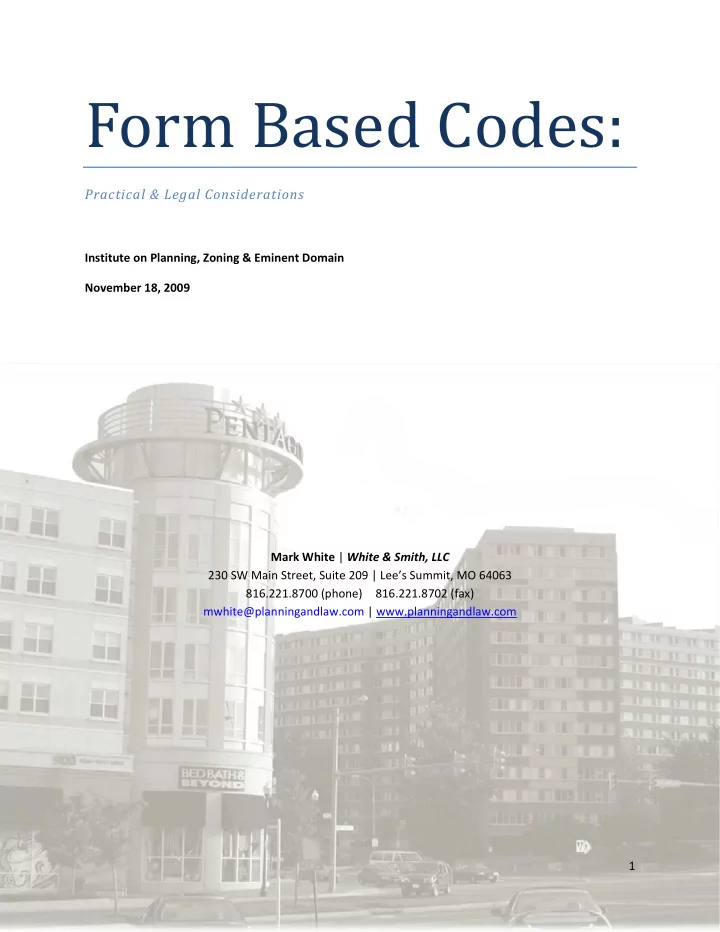

Form Based Codes: Practical & Legal Considerations Institute on Planning, Zoning & Eminent Domain November 18, 2009 Mark White | White & Smith, LLC 230 SW Main Street, Suite 209 | Lee’s Summit, MO 64063 816.221.8700 (phone) 816.221.8702 (fax) mwhite@planningandlaw.com | www.planningandlaw.com 1
Form Based Codes: Practical & Legal Considerations Contents Introduction .................................................................................................................................................. 3 What is a Code? ............................................................................................................................................ 5 Code Ingredients ........................................................................................................................................... 7 Form ‐ Based Code Models ........................................................................................................................... 13 Steps to Code Reform ................................................................................................................................. 13 Legal Requirements .................................................................................................................................... 15 Case Summaries .......................................................................................................................................... 18 Conclusions ................................................................................................................................................. 26 Pennsylvania Traditional Neighborhood Development Statute ................................................................. 27 Dallen v. Kansas City (1991) ........................................................................................................................ 35 2
Form Based Codes: Practical & Legal Considerations Introduction With the rise of New Urbanism as a trend in urban planning, local governments are increasingly turning to their zoning and land development codes to encourage or require better development design. These design ‐ oriented codes are often referred as “form based codes.” A “form based code” is a code is one that abandons the use ‐ based orientation of a conventional zoning ordinance, and focuses instead on design characteristics. A better term might be a “design based code,” but for purposes of this paper I will use the term widely used by its proponents. The Form ‐ Based Codes Institute, a group of practitioners who are advancing the concept, defines a form ‐ based code as: "A method of regulating development to achieve a specific urban form. Form ‐ based codes create a predictable public realm by controlling physical form primarily, with a lesser focus on land use, through city or county regulations." The FBCI suggests that a form ‐ based code have the following elements: Element Description Mandatory Elements: Regulating Plan A plan or map of the regulated area designating the locations where different building form standards apply, based on clear community intentions regarding the physical character of the area being coded. Building Form Standards Regulations controlling the configuration, features, and functions of buildings that define and shape the public realm. Public Space/Street Specifications for the elements within the public realm (e.g., Standards sidewalks, travel lanes, street trees, street furniture, etc.). Administration A clearly defined application and project review process. Definitions A glossary to ensure the precise use of technical terms. Optional Elements: Architectural Standards Regulations controlling external architectural materials and quality. Landscaping Standards Regulations controlling landscape design and plant materials on private property as they impact public spaces (e.g. regulations about parking lot screening and shading, maintaining sight lines, insuring unobstructed pedestrian movements, etc.). 3
Form Based Codes: Practical & Legal Considerations Signage Standards Regulations controlling allowable signage sizes, materials, illumination, and placement. Environmental Resource Regulations controlling issues such as storm water drainage and Standards infiltration, development on slopes, tree protection, solar access, etc. Annotation Text and illustrations explaining the intentions of specific code provisions Source: FBCI, at http://www.formbasedcodes.org/definition.html. The FBCI lists six (6) jurisdictions that have adopted form ‐ based codes: Petaluma, California; Azusa, California; Arlington, Virginia (Columbia Pike Special Revitalization District Form Based Code); Oakland, California (New Pleasant Hill BART Station Property Code); Woodford County, Kentucky; Sonoma, California; and Ventura, California. 1 Farmer's Branch, Texas has also adopted a form ‐ based code for transit ‐ oriented development areas. Many more jurisdictions throughout the nation have adopted codes that would qualify as a form ‐ based code under the FBCI's definition. Form ‐ based codes are not a new phenomenon. Communities have long focused applied design based codes to specific areas, such as historic districts or neighborhoods. Others have used design review boards to dictate the physical form of new development. These codes typically focused on architectural style, and often exposed new development to very general language and discretionary review processes. What separates form based codes from the older design based codes the application of broader set of design principles and the use of specific standards in lieu of case ‐ specific review processes. While a form based code could apply to a variety of settings, they are typically used to achieve a compact physical form. The standards typically focus on achieving a relationship between buildings and streets and encourages walking, transit and a tighter neighborhood fabric rather than a specific architectural style. A number of communities have adopted form based codes. Most apply them to specific situations, such as a downtown area or an urban corridor. For example, Arlington County, Virginia adopted one of the first so ‐ called “form based codes” for the 3 ‐ mile Columbia Pike corridor. Older form based codes adopted standards for “traditional neighborhood developments” (TNDs) – or new communities with a mix of uses and a compact form that form a complete community. For example, San Antonio adopted a comprehensive set of “Use Patterns” in its 2002 Unified Development Code for TNDs, transit oriented development, commercial centers in existing neighborhoods, campus style development, and the retrofit of existing malls and other commercial areas. In the mid ‐ 1990s, several smaller communites in 1 See Form ‐ Based Codes Institute (FBCI) website at http://www.formbasedcodes.org/resource.html. 4
Recommend
More recommend